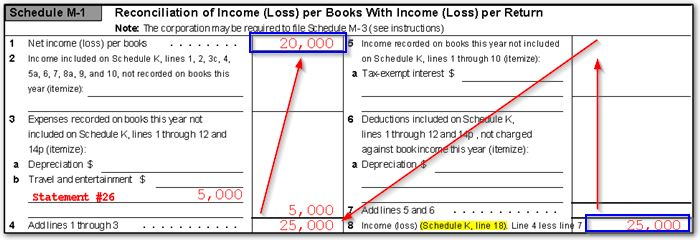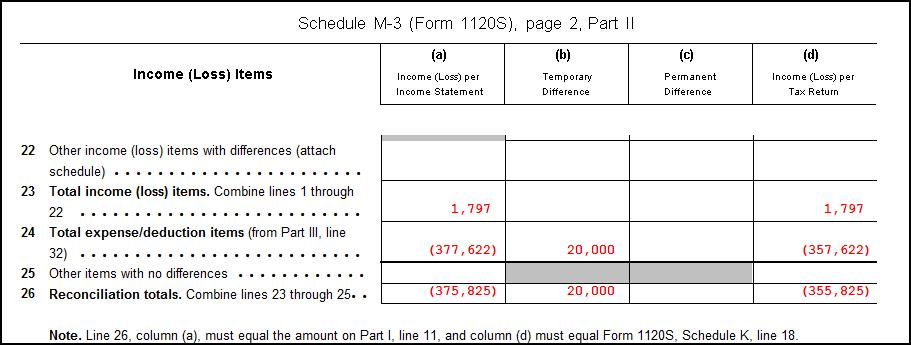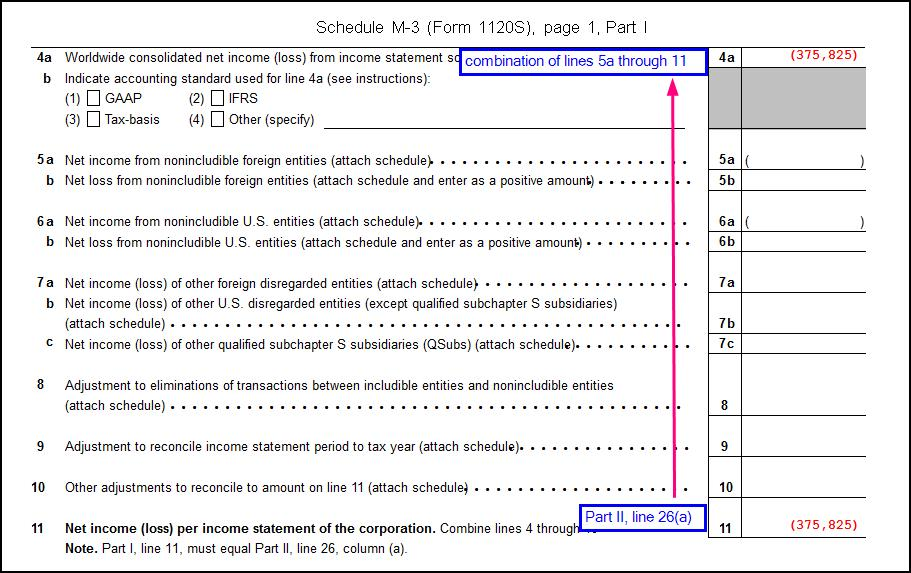Drake Tax - 1120-S - Calculating Book Income, Schedule M-1 and M-3
Article #: 10411
Last Updated: November 03, 2025

Schedule M-1 is required when the corporations gross receipts or its total assets at the end of the year are greater than $250,000. The calculation for Schedule M-1 is done in reverse from the form itself. The taxable income reported on Schedule M-1, line 8, is available from the calculation of Form 1120-S, page 3, Schedule K, line 18; Schedule M-1, line 1, “Net income (loss) per books,” is not available without book-to-tax adjusting entries. The calculation for the Form 1120-S, Schedule M-1, is as follows:
-
Line 8
-
Add line 6
-
Add line 5
-
Subtract line 3
-
Subtract line 2

The end result reported on Schedule M-1, line 1, should match the amount reported on the financial reporting statements for the corporation’s book income.
Amounts Origins
Line 4, “Income included on Schedule K, lines 1, 2, 3c, 4, 5a, 6, 7, 8a, 9, and 10, not recorded on books this year” - Certain credit forms require that the amount of credit be included in other income. The increased income is a tax item only and is not generally included in book income. The increased income amount flows to this line automatically. Additional income items reported for tax purposes, but not included in book income, are entered on the M1 screen, line 2.
Line 3a, “Depreciation” - This is the book-to-tax adjustment for depreciation that is made when book depreciation is greater than tax depreciation. The program makes the adjustment automatically based on entries in the return. The amount calculated by the program can be overridden on the M1 screen, line 3, “Book-to-tax depreciation adjustment.”
Line 3b, “Travel and entertainment” - Meals and entertainment limitations are carried from amounts entered on the DED screen.
Line 3 - “Expenses recorded on books this year not included on Schedule K, lines 1 through 12 and 14p” other than depreciation and travel and entertainment, flow automatically from amounts entered on the return. This line can be adjusted on the M1 screen, line 3 "Other." The amounts that are carried automatically by the program are:
-
Certain credit forms that require that the amount of credit reduce the expense attributable to the credit. The program automatically reduces the expense amount for Form 1120-S, page 1, lines 8, 12, or 19, depending on the credit type. The decreased expense is a tax item only and does not generally decrease the book expense. The decreased expense amount book-to-tax adjustment is carried to this line automatically. Additional expense items reported for book purposes, but not deducted on the return, are entered on the M1 screen, line 3, "Other."
-
Certain nondeductible expenses, such as penalties and fines, and officer life insurance premiums, can be entered on screen K on the AMT and Basis tab, line 16c, "Nondeductible Expenses."
-
The amortization book-to-tax adjustment is made when book amortization is greater than tax amortization. The program makes the adjustment automatically based on entries in the return. The amount calculated by the program can be overridden on the M1 screen, line 3, “Book-to-tax amortization adjustment.”
Line 5a, “Tax-exempt interest” - This includes interest, such as interest received on state or local bonds, and is excluded from gross income. This amount is entered on screen K on the AMT and Basis tab, line 16a.
Line 5 - Includes other income reported on the corporation’s books for the year but excluded from the tax return. These include certain officer life insurance proceeds, and gains on certain installment sales. Amounts entered on the M1 screen, line 5 - Other adjust those amounts carried from the K1P screen, line 18, code B.
Line 6a, “Depreciation” - This is the tax-to-book adjustment for depreciation that is made when tax depreciation is greater than book depreciation. The program makes the adjustment automatically based on entries in the return. The amount calculated by the program can be overridden on the M1 screen, line 6, "Tax-to-book depreciation adjustment."
Line 6 - “Deductions included on Schedule K, lines 1 through 12, and 14p, not charged against book income this year,” other than depreciation and amortization adjustments, are entered directly on the M1 screen, line 6, "Other." No amount is carried to this line automatically.
Line 6 - The amortization tax-to-book adjustment is made when tax amortization is greater than book amortization. The program makes the adjustment automatically based on entries in the return. The amount calculated by the program can be overridden on the M1 screen, line 6, "Tax-to-book amortization adjustment."
Schedule M-3
Schedule M-3 is required when the corporation’s total assets at the end of the year are $10 million or more. The calculation for Schedule M-3 is done in reverse from the form itself. The first step in the calculation is the equalization of the taxable income reported on Schedule M-3, Part II, line 26, column (d), which must match Form 1120-S, page 3, line 18. Until that amount is correct, the book income reported on Schedule M-3, Part I, line 4a, will be wrong.
The program makes the calculation for Schedule M-3, Part I, line 4a, in the following manner:
-
Page 1, Part I, line 11 is determined by page 2, Part II, line 26, column a, which is calculated in the following manner:

-
Page 2, line 26, column d
-
Page 2, line 26, column c
-
Page 2, line 26, column b
-
Page 2, line 26, column a

-
-
Subtract the positive amount from Part I, line 10, and add the negative amount from Part I, line 10 entered on the M3 screen
-
Subtract the positive amount from Part I, line 9, or add the negative amount from Part I, line 9 entered on the M3 screen
-
Subtract the positive amount from Part I, line 8, or add the negative amount from Part I, line 8 entered on the M3S screen
-
Subtract the positive amounts from Part I, lines 7a, 7b, and 7c, and add the negative amounts from Part I, lines 7a, 7b, and 7c entered on the M3S screen
-
Subtract the positive amounts from Part I, line 6b, and add the negative amount from Part I, line 6a entered on the M3S screen
-
Subtract the positive amounts from Part I, line 5b, and add the negative amount from Part I, line 5a entered on the M3S screen
The end result reported on Schedule M-3, Part I, line 4a, should match the net income (loss) amount reported on the corporation’s worldwide consolidated net income statement.
For more information, see the Form 1120-S Instructions.